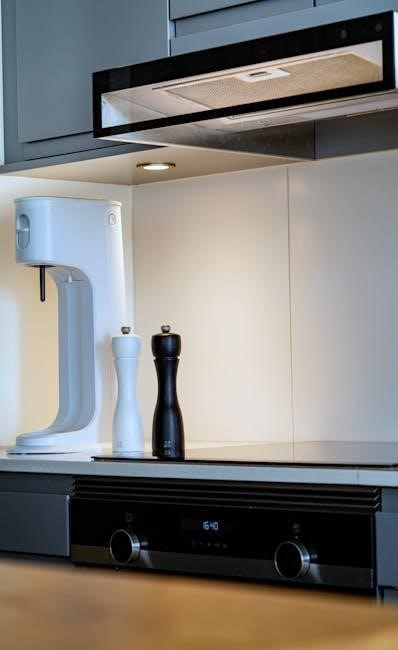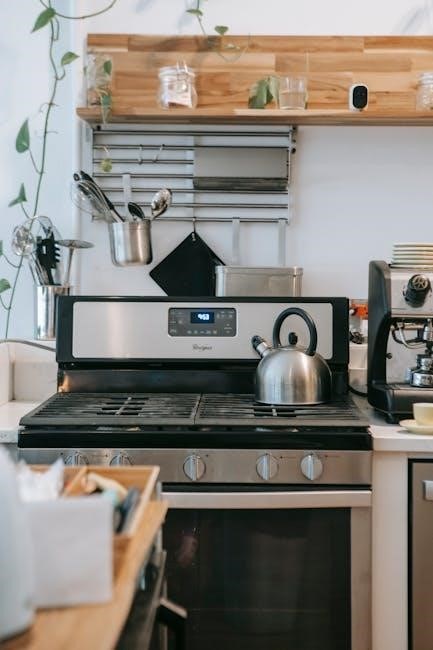Understanding the Self-Clean Feature
The self-clean feature on GE ovens uses high heat to decompose food residue into ash, eliminating the need for harsh chemicals․ This efficient process saves time and effort, making oven maintenance easier and safer․ Perfect for deep cleaning, it reaches extreme temperatures to sanitize the interior thoroughly․
How the Self-Clean Cycle Works
The self-clean cycle on a GE oven operates by using extremely high temperatures, reaching up to 880°F (471°C), to incinerate food residue and spills into ash․ This process is automated and requires no manual scrubbing․ Once activated, the oven door locks for safety, and the cycle runs for several hours․ After completion, the oven cools down, and the ash can be easily wiped away․ This method ensures a thorough and efficient cleaning without the need for harsh chemicals․
Benefits of Using the Self-Clean Feature
The self-clean feature offers significant advantages, including time savings and effortless oven maintenance․ It eliminates the need for harsh chemicals, reducing exposure to toxic fumes․ High heat effectively breaks down tough food residue, leaving behind only ash that’s easy to wipe away․ This feature also enhances safety by locking the oven door during the cycle, preventing burns and ensuring a controlled environment․ Additionally, it promotes energy efficiency and prolongs the oven’s lifespan by removing grime that could affect performance․ Overall, it’s a convenient, eco-friendly, and effective cleaning solution․
Safety Precautions for Self-Cleaning
Always follow safety guidelines when using the self-clean feature․ Ensure the oven door is locked, and keep children away․ Proper ventilation is essential to avoid fumes․
Important Safety Instructions
Always follow safety guidelines when using the self-clean feature․ Ensure the oven door is locked, and keep children away․ Proper ventilation is essential to avoid fumes․ Do not use the oven for storage during the cycle․ Keep the area clear of flammable materials․ Avoid using harsh chemicals, as they can damage the oven’s finish․ Never leave the oven unattended during the self-clean process․ Ensure the anti-tip device is properly engaged to prevent accidents․ Follow all instructions in the GE Appliances owner’s manual for safe operation․
Risk of Tipping and Anti-Tip Device Information
The risk of tipping exists if the anti-tip device is not properly engaged․ This device prevents the range from tipping when the oven door is open․ Ensure the anti-tip bracket is securely installed and engaged when the range is pushed back against the wall․ Failure to do so may result in the range tipping, causing injury․ Always refer to the GE Appliances manual for specific instructions on the anti-tip device to ensure safe operation and prevent accidents․
Preparing for the Self-Clean Cycle
Preparing for the Self-Clean Cycle involves removing racks and accessories, cleaning spatters, and ensuring the oven is empty․ This ensures a safe and effective cleaning process, leaving your oven spotless and maintained․
Removing Oven Racks and Accessories
Before starting the self-clean cycle, remove all oven racks, shelves, and accessories to prevent damage from high heat․ Cover the floor with paper to catch debris․ Wash racks separately by hand or in the dishwasher․ This step ensures a safe and effective cleaning process, avoiding any obstruction or damage during the cycle․
Cleaning Spatters and Spills Before the Cycle
Clean spatters and spills on the oven front frame and door outside the gasket with a damp cloth and detergent or a soap-filled steel wool pad․ These areas are not cleaned by the self-clean cycle․ Remove any heavy residue to ensure optimal performance during the high-heat process․ This step prevents stubborn stains and ensures a more effective cleaning result․
Running the Self-Clean Cycle
Understanding the High Heat Process
The self-clean cycle uses high heat, reaching up to 880°F, to turn food residue into ash․ This intense process ensures a deep clean without harsh chemicals․
Step-by-Step Instructions for Activating the Cycle
To activate the self-clean cycle on your GE oven, start by ensuring the oven is empty of racks and accessories․ Turn the temperature knob to the “Clean” position or select the self-clean option on the digital display․ The oven will lock and heat to a high temperature, typically around 880°F, to incinerate food residue․ Allow the cycle to complete, then let the oven cool before wiping away ash with a damp cloth․
The self-clean cycle uses extreme heat, up to 880°F, to convert food residue into ash․ This high-temperature process ensures thorough cleaning without chemicals․ The oven locks during the cycle for safety․ It typically takes 2-4 hours, depending on soil level․ Afterward, allow the oven to cool before wiping out ash․ This method is efficient but requires careful preparation to avoid damage or hazards․

Post-Cleaning Maintenance

After the self-clean cycle, remove ash and residue with a damp cloth․ Clean the oven door and exterior using mild detergent and water to restore shine and functionality․
Removing Ash and Residue
After the self-clean cycle, allow the oven to cool completely․ Use a damp cloth or soft sponge to wipe away ash and residue․ Avoid using abrasive materials or harsh chemicals, as they may damage the oven surfaces․ For stubborn spots, lightly scrub with a non-abrasive cleaner․ Rinse thoroughly and dry with a clean cloth to prevent streaks․ This step ensures a clean and safe oven interior, ready for future use․
Cleaning the Oven Door and Exterior
After the self-clean cycle, clean the oven door and exterior separately․ Use a damp cloth with detergent and hot water to wipe down the door and outer surfaces․ Avoid harsh chemicals or abrasive materials that could damage finishes․ For heavy soil, a soap-filled steel wool pad can be used gently․ Ensure all areas are dry and streak-free after cleaning․ This maintains the appearance and functionality of your GE oven, keeping it looking like new․

Troubleshooting Common Issues
If the oven doesn’t cool down or emits odors/smoke during the cycle, ensure proper ventilation, check for blockages, and verify the oven is empty․ Allow it to cool before addressing issues․
What to Do If the Oven Doesn’t Cool Down
If your GE oven doesn’t cool down after the self-clean cycle, ensure proper ventilation in the kitchen․ Allow the oven to cool for 30-90 minutes as recommended․ Check that the cooling fan is operational and unobstructed․ Verify that no food or racks are blocking the vents․ If the issue persists, consult the owner’s manual or contact GE support for assistance․ Always prioritize safety and avoid using the oven until it has cooled sufficiently․
Addressing Odors or Smoke During the Cycle
During the self-clean cycle, odors and smoke may occur due to food residue burning․ Ensure proper ventilation by opening windows and using exhaust fans․ If smoke persists, stop the cycle and let the oven cool slightly before restarting․ Light smoke is normal, but excessive smoke may indicate heavy buildup․ Check for obstructions in vents and ensure racks are removed․ For severe odors, leave the oven door slightly open after the cycle․ Always follow safety guidelines in the GE manual to manage these issues effectively․
Additional Resources
Download the GE Appliances owner manual for detailed instructions and guidelines․ Connect your oven to smart devices for enhanced functionality and remote monitoring through the GE app․
Downloading the GE Appliances Owner Manual
Download the GE Appliances owner manual for your self-cleaning oven to access detailed use and care guidelines, installation instructions, and feature-specific information․ This digital resource is available online, covering models like JBP25, JBP45, and more․ It provides step-by-step guidance for operating the self-clean cycle, safety precautions, and troubleshooting tips․ Ensure you have the latest version for accurate instructions tailored to your specific oven model․
Connecting Your Oven to Smart Devices
Your GE oven can be connected to smart devices using your home’s existing Wi-Fi network․ Follow the on-screen instructions in the GE Appliances app to establish a connection․ Once linked, you can monitor and control your oven remotely, ensuring convenient operation․ This feature enhances accessibility and allows for seamless integration with your smart home system, making cooking and maintenance more efficient and user-friendly․
Regularly using the self-clean feature ensures your oven stays in prime condition․ Always follow safety guidelines and maintenance tips for optimal performance and longevity of your appliance․
Best Practices for Maintaining Your Oven
Regularly using the self-clean feature ensures your oven remains clean and efficient․ For light cleaning, wipe down surfaces with a damp cloth after each use․ Remove racks and accessories before starting the self-clean cycle to prevent damage․ Avoid using abrasive cleaners, as they can scratch surfaces․ For tough stains, use a gentle scrubber or soap-filled pad․ Clean the exterior with a damp cloth and mild detergent․ Always check and clean the oven door gasket for a proper seal․ Ensure the anti-tip device is engaged to prevent accidents․ These practices help maintain your oven’s performance and longevity․
When to Use the Self-Clean Feature
The self-clean feature is ideal for deep cleaning after heavy use or when food residue has built up․ Use it when you notice stubborn stains or odors․ Avoid using it before light cleaning tasks, as the high heat cycle is designed for thorough sanitizing․ Start the cycle when you have enough time, as it can take several hours to complete․ This feature is perfect for maintaining your oven’s hygiene and efficiency without frequent manual scrubbing․
